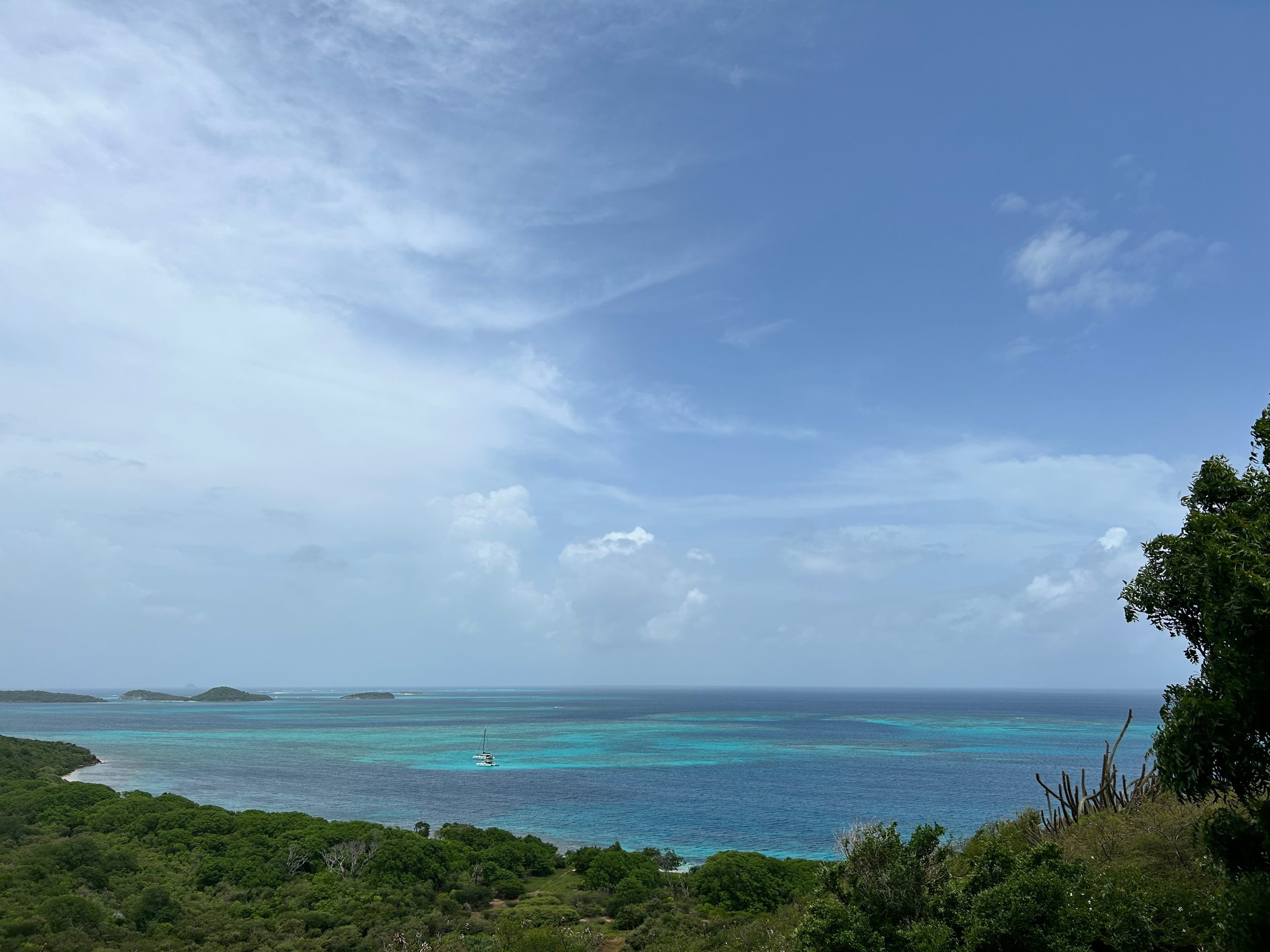Mayreau island is a cultural bastion where — despite challenges — community spirit is alive and adaptive
This is the first instalment of a two-part post under the Shared Island Stories initiative, supported by the School of Art History at the University of St. Andrews in Scotland, which explores ways in which to build collaborative tools to inform case studies in support of the project “Sacred Space and Social Memory: Interrogating Co-becoming in Community-Based Practices in the Grenadines and the Isle of Skye.”
Funded by UK Research and Innovation (UKRI) with project reference: EP/X023036/1.
Many thanks to Janine Mendes Franco and Skye Hernandez for the editing assistance and publishing on Global Voices ‘The Bridge.’ This would not be possible without the support of We Are Mayreau’s director, Marion Isaacs.
Community-based coral restoration and livelihood diversification in St. Lucia and St. Vincent and the Grenadines, titled “Building climate resilience for food and water security in two SIDS through EbA (B- Resilience4SIDS),” funded by the Inter-American Foundation (IAF). Image courtesy We Are Mayreau, Inc., used with permission.
The two-hour trip to Mayreau from Bequia across the transboundary Grenadines — a group of nearly 100 islands that form part of Grenada and St. Vincent and the Grenadines — is a 45-kilometre trip south by fast ferry. It began with the glassy grey waters and overcast skies of August. Much-needed rain welcomed us upon arrival; the system grew into Hurricane Franklin, dumping over 12 inches of rain on the Dominican Republic days later.
The sudden cooling felt like we were nestled in a cosy, verdant space surrounded by families and new friends, setting the tenor of the days to come. You know something is different about a place when the community welcomes you with hugs, hand squeezes, smiles like they have known you for a long time, music, food, and drink for all. We were amid a family reunion, an “ole talk” session — a Mayreau “lime.”
We Are Mayreau Coral Restoration Team!
Why Mayreau?
My interest in entangled colonial and imperial histories, livingness, heritage stories, spiritual practices and social activism has fuelled questions about how Vincentian tangible and intangible heritages are affected by the communities’ relationship to land, ongoing foreign investment and settlement, one another, and the more-than-human world.
The Isle of Skye parallels some of these Caribbean realities, including a housing crisis brought on by the sale of properties to wealthy British investors, the emigration of youth due to the housing and employment crisis, the imperialist diminution of Indigenous cultures, and the ways in which tourism and land expropriation have shifted the ways that people engage with land, rituals, customs, and heritage. Community-based practices are looking at alternative routes to belonging, justice and reparation and, while the spaces are very different, commonalities exist in the challenge of trying to belong.
I therefore happily jumped body and heart first into several impromptu, no-holds-barred conversations with We Are Mayreau’s (WAM) director, Marion Isaacs, a resolute, empathetic and community-spirited leader, activist and tradition holder who spoke of the financial, governance and environmental landscape of the southern Grenadines and the challenges it faces, along with the positive transformation in which the organisation continues to participate.
The all-women's non-profit was formed in 2016, with the goal of improving access to education and training for community members. WAM aims to improve access and participation, health and well-being for members of its small island community, and is focused on holistic empowerment, which encompasses issues of people, culture and the natural environment.
We Are Mayreau Community Centre
The Tobago Cays Marine Park
Mayreau, with its population of approximately 350 people, is part of the Tobago Cays Marine Park (TCMP). Four of its cays — Petit Rameau, Petit Bateau, Jamesby and Baradal — lie within the semicircular, aptly named Horseshoe Reef. A fifth, Petit Tabac, lies just outside the well-developed Holocene bank-barrier reef, one of the longest — approximately 4 km — in the southern Grenadines. Mayreau is located west on the circle's periphery and the island has used this area for its ongoing Coral Restoration Project.
The Tobago Cays were designated a conservation area in 1987 under Fisheries Regulations, and the TCMP was created in late 1997. Coral reefs are essential to marine biodiversity conservation, housing seagrass beds and important feeding groups, and offering breeding grounds for threatened turtles and other marine life. Mayreau itself has vulnerable but extant endangered mangroves.
The island's land tenure laws were plantation/estate-bound until the 1990s when the Vincentian government advocated for acreage to be released for sale from the Eustace family, who had held sole possession from 1942, with prior ownership from 1822 — pre-emancipation — in the hands of the Saint Hilaire family. Many residents are therefore now first and second-generation landholders.
Mayreau families enjoying sea time during summer holidays.
On the frontline of the climate crisis
WAM’s team of six divers, boat crew and data keeper set off to two sites in the TCMP — which has a complex, contentious and severely under-studied history — to capture evidence, clean and remove various types of coral that were either dead, bleached or otherwise adversely affected.
The garden of branching coral beds lays nine to 15 feet deep. Seeing the team caring for the beds felt like a gesture of love, resistance, intimacy and healing, while simultaneously impossible — Sisyphean, almost — like putting a bandaid on a gaping wound, especially in a world where the climate emergency and ongoing poly-crises are on blast via loudspeaker. If the soupy temperature of the water was not scary enough, Isaacs told me upon surfacing to share a number count, September and October are even worse. It is hard to imagine marine life finding sanctuary and spawning grounds in a hot, hot sea.
The Global South and, in particular, the Small Island Developing States (SIDS) of the Caribbean are witnessing first-hand the reverberations of being on the frontline of the climate emergency. Repercussions of the COVID-19 pandemic, the 2021 La Soufrière volcanic eruptions, historical social deficits due to colonisation, climate injustice, disaster capitalism and weak national advocacy continue to wreak havoc across the socially-stalled country.
However, there is a silver lining: The International Monetary Fund predicts that St. Vincent and the Grenadines’ economy will grow by six percent in 2023 and by five percent in 2024. However, a 2016 UNESCO study found that 30 percent of its citizens lived in poverty, a rate higher than the 23 percent average for the rest of the Eastern Caribbean. The juxtaposition brings to mind what the old people say when trouble comes: to “band our bellies,” or prepare for difficult times.
Tobago Cays to the left with the diving gardens to the right. They are the most fertile and untouched gardens in the country. September 2023 brought unprecedented warming to the seas which impacted the growth of the Elkhorn coral and other species.
‘Blue economy’ challenges
The remainder of the day was filled with conversations about the changing marine environment and speculation about the causation of the many coral graveyards that dot the TCMP. Coral death can be attributed to rising global sea temperatures, but this is not the only culprit. Increased sea traffic, pollution, bacteria, and other pathogens continue to infiltrate the protected waters of the TCMP due to increased yacht tourism in the park over the last 20 years.
Statistics from 1999 show that more than 14,000 yacht persons, 25,000 charter boat day-trippers, and 10,000 cruise ship passengers visit the Cays annually — and while tourism is the lifeblood of families across the southern Grenadines, many environmental sacrifices and unseen extinctions underlay exploitative settler tourism and “development,” irrespective of how it is disguised, adorned and represented.
Recently, the country negotiated fiscal and reform assistance via the World Bank through the International Development Association, cooperating on a development policy credit line of USD 30 million to finance St. Vincent and the Grenadines’ blue growth agenda, which will “continue to increase fiscal resilience, strengthen the country’s climate resilience, and extend disaster risk management reform efforts to better prepare for and respond to emergencies.”
With this large sum, as well as other gifts and loans being offered to the Vincentian government, how are funds, initiatives and projects being implemented and communicated to the public? How are these actions impacting community-based organisations and grassroots initiatives that have historically engaged in change-making work in their locales? Are there sufficient incubation projects accommodating habitat creation, ecological education, or the management of invasive species? Are fisheries and the agricultural sectors working to counter overfishing or banning toxic pesticides and agrochemicals that provide nitrogen-rich waters for increasing sargassum blooms, which impacts the quality of life in coastal communities and marine life, including coral?
Plans for a blackfish processing plant
The government, meanwhile, promises an “aggressive thrust to increase fishing activity in our waters” through an alliance with Japan to build the Barrouallie Blackfish Processing Plant. While there are urges to address sustainability and regulations on how the marine environment is used as a presumably “regenerative” and “inexhaustible” resource, have we become so blind by hubris that we deny the rights of our terrestrial and marine kindred — fauna and aquatic sentient life — in favour of fuller pockets?
Can our governance be aligned with the values of an honourable harvest, where we consider the lifespan and gift of the more-than-human world rather than perpetuating capitalist, extractivist, patriarchal aggression and thrusting? Are we looking at neighbouring countries and their growing troubles with coastal erosion, pollution, deep sea mining, overfishing and endangerment or loss of species and habitat — most notably, the shifts in migratory patterns of flying fish in Barbados, ongoing disputes with Trinidad and Tobago, the drastic decline of the sea urchin population, and the endangerment of the Queen Conch in The Bahamas?
Mayreau Salt Pond.
Countering colonial extractivism
Much of the existing foreign investment across the Grenadines cannot be labelled progressive, equitable, reciprocal, environmentally conscious, decolonial or critical of the values of extractive neocolonial tourism. The way tourism is routinely represented with aspects of hyper-exotification and exploitation, coloured by undercurrents of racism and classism, is damaging to the ecological, psychological, socio-economic and spiritual health of most people living in the Grenadines.
Recent and ongoing public protests due to “settler/investor/lessee” encroachment on Canouan, limiting beach access, and the reselling of leased free holds — set in motion under the 99-year lease agreement for 1,200 acres of the 1,800-acre Canouan island signed in 1990 — continue to sour an already bitter pot as Grenadines people watch, most with discouragement, some with fire in their bellies, the continued privatisation of their island homes.
Quite apart from the continued violation of national patrimony in Canouan, this is all currently happening on the private islands of Mustique, Palm/Prune Island and Petit St. Vincent. The government has enacted eminent domain, allowing the purchase of the Tobago Cays from American investor Nicholas Fuller, who bought them in 1960 from the aforementioned Eustace family.
With this more comprehensive social, historical and environmental view in mind, it is clear to see why Grenadines’ initiatives like We Are Mayreau, SUSGREN, Union Island Environmental Alliance, The Hub Collective, Sandwatch, #GreeningtheGrenadines via Chatoyer Gardens, and other community-based organisations that are working diligently on heritage, culture, psychosocial recovery and community and environmental healing, are essential to the ongoing repair, restoration, reparations and rehabilitation which are urgently needed across the Grenadines.






